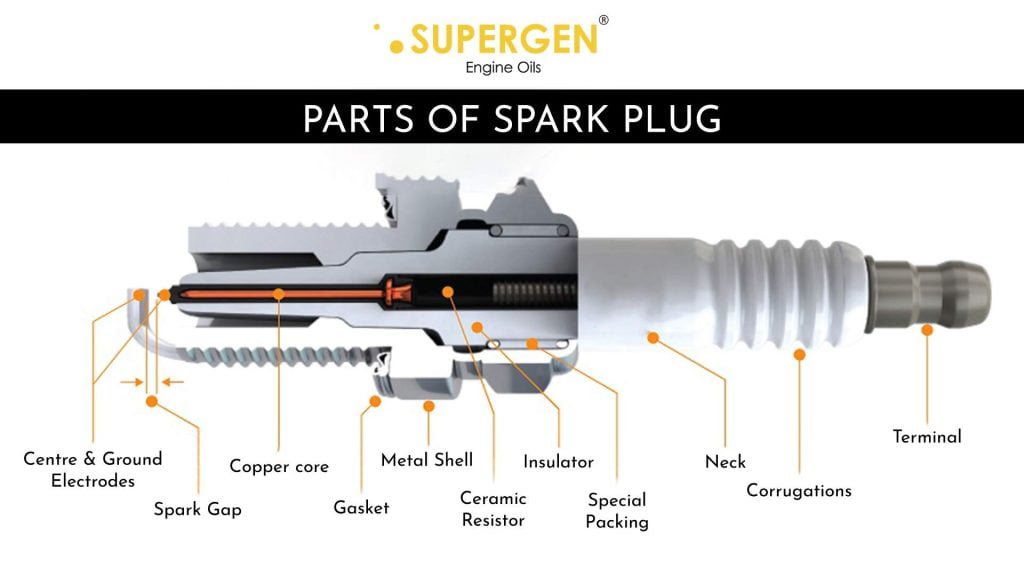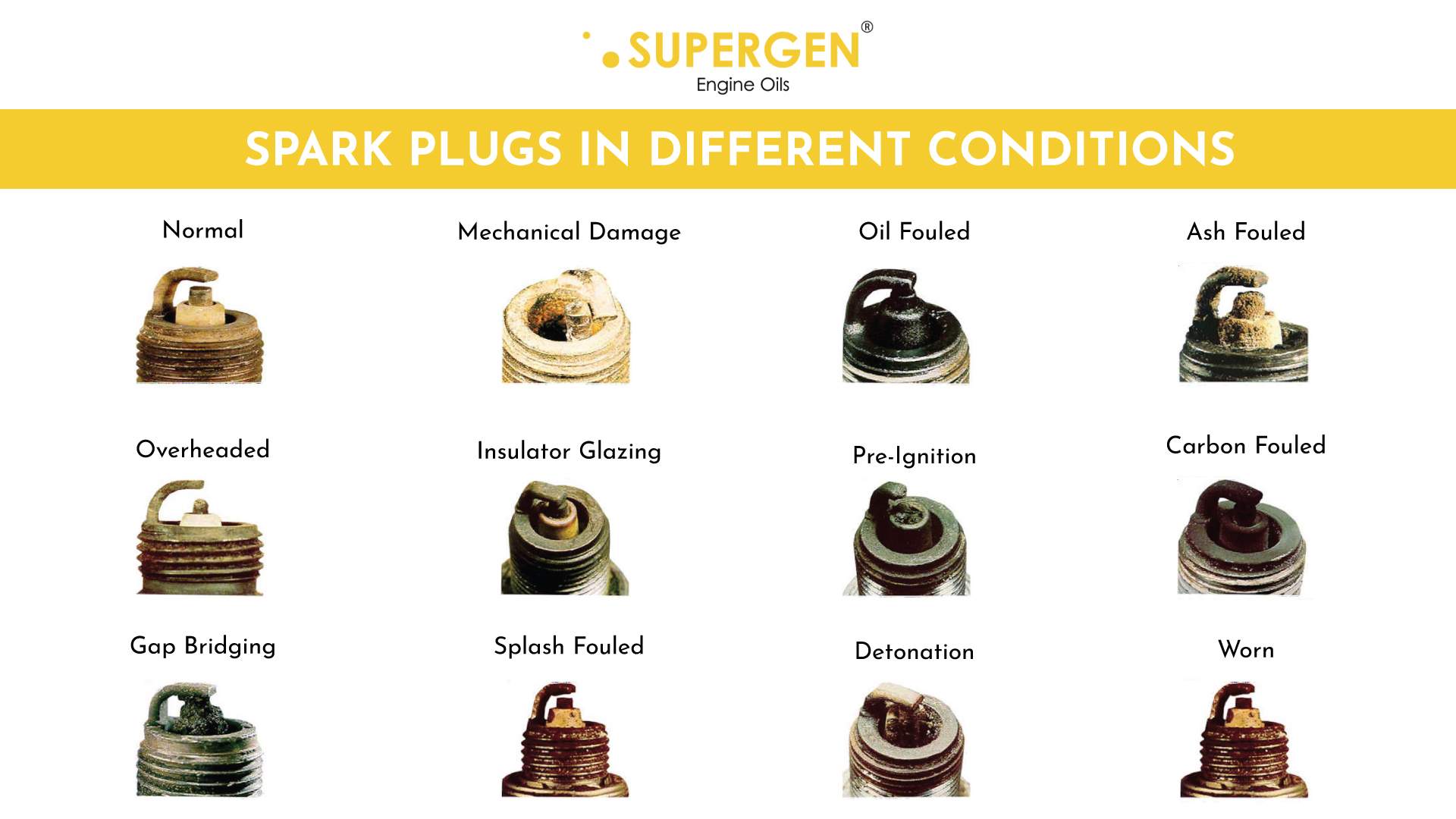Spark Plugs - A Complete Guide
What do spark plugs do?
Spark plugs are essential components of the car’s engine. An engine consists of a combustion chamber, which holds the air/fuel mixture.
The engine also consists of pistons, which need to move in order to propel the car forward. Now, this is where the spark plug comes in.
The spark plugs emit a small burst of electricity which ignites the air/fuel mixture and puts the pistons into motion. This allows the car to power up and stay in motion effectively.
Without a spark plug, starting the car would be impossible and so would driving it anywhere. Since spark plugs are essential to the functioning of the engine, they directly affect the overall performance of the car.
Without a well-functioning spark plug, your car will face a huge number of issues. These include things like misfiring, issues with acceleration, high fuel consumption, etc.
What are the parts of a spark plug?
In order to ascertain whether or not your spark plugs are working fine, it is necessary to understand the structure of the spark plug. This includes the major parts of the plug and the functions that they carry out. Here is a basic guide to the parts of a spark plug

Plug Terminal
This is the part of the spark plug that is connected to the high tension cable coming from the distributor cap. The terminal conducts the high voltage to the central electrode.
Ceramic Insulator
The insulator acts as a barrier between the central electrode and the earth at up to 40,000 volts. This part is often made from aluminium oxide ceramic and can either be plain or have profiles.
Metal Body
The metal body of a spark plug is a steel structure with threads that ensure a secure fit and makes it easy to remove and install. The body also provides electrical ground to the cylinder head and cools the plug by transferring heat to the cylinder head.
Central Electrode
The central electrode is made from a nickel based alloy with copper in it. It also has platinum or iridium, depending on the type. High voltage is applied to this electrode from the secondary winding through the distributor.
Ground Electrode
This electrode is welded to the metal body of the spark plug. This too, is made of nickel based alloys with iridium or titanium reinforcement.
Sealing Washer/Gasket
The gasket is meant to seal the cylinder head. It also helps cool down the spark plug.
Insulator Tip
This is the part of the plug that extends into the combustion chamber. This part determines the thermal rating of the plug.
Electrode Gap
The distance between the central and ground electrode is the electrode gap. This gap is essential in ignition. If the gap is not correct, then the spark provided would not be sufficient to ignite and would lead to misfiring of the engine.
What happens to spark plugs with time?
Since spark plugs ignite the fuel in the compression chamber, they withstand extreme temperatures and pressures. The quality of the spark plug determines how well it fares in such circumstances.
However, even the best spark plugs will go through wear and tear over time.
As spark plugs get older, their interaction with the air/fuel mixture in the engine gives rise to certain deposits. These deposits keep building up on the spark plugs and slowly affect their functioning.
Deposits on the spark plugs can cause the fuel to pre-ignite i.e. ignite even without the car being started or igniting too fast. This can be jarring for the driver and damaging for the car.
Furthermore, over time, the spark plugs also lose their ability to ignite properly. When a spark is ignited, it travels across a small gap to provide combustion at the right moment.
However, when spark plugs get older, this gap widens due to wear and tear. This causes the combustion of the engine to become erratic. Thus, it is clear that with age, spark plugs can become very ineffective due to extreme temperatures and deposits.
How often do spark plugs need to be changed?
Unlike engine oil or oil filters which need to be changed quite often, spark plugs have a long life and can go on for years before having to be replaced.
Every car comes with an owner’s manual that specifies how often the spark plugs need to be changed for that particular model. However, on an average, you should change spark plugs after about 50,000 km.
This duration also depends upon the quality of the spark plug and the design of the engine.
How to remove spark plugs?
If you suspect that there are some issues with your spark plugs, it can be beneficial to remove the spark plugs and inspect them personally. Since the spark plug is a delicate component of the engine, it is generally best to leave this to professional mechanics. However, auto repair enthusiasts can follow these steps to remove spark plugs themselves:
- The spark plugs can be difficult to find, but in order to remove them, you will first need to locate them in the engine. It might be helpful to find the ignition wire and follow it to find the spark plug, which may also be hidden under some engine parts such as the ignition coil.
- Once you have located the spark plug, you would need to disconnect it from the socket using a spanner. Make sure you pull on the spark plug carefully and do not damage the wire in the process.
- Once the spark plug has been pulled out, you can use a wrench to turn the plugs and rotate them out of the actual socket. If the plug has been fitted tightly, this might be tough and take some time. It is important to be patient and not damage the parts in a hurry. You may also use some oil to loosen the plugs.
- Once the spark plug is out, you can start to inspect it or clean it, if needed. This process can then be repeated for all spark plugs.
How to inspect spark plugs?
Once the spark plugs are removed from the engine safely, it is time to inspect them well and find out if there is any serious damage. A normal spark plug should have some brown or grey deposits on the side electrode. If your spark plug looks normal, without signs of serious damage, you can go ahead and clean it according to the steps mentioned later on. However, there are certain types of damaged spark plugs you should look out for:

Carbon fouled
If you see black, dry soot on the electrodes of the spark plug as well as the insulator, then it shows that the plug is carbon fouled. Dirty air filter, driving at very low speeds or idling your vehicle too long can cause this sort of damage.
Oil deposits
If you notice black grease or oil deposits on the electrodes or insulator tips of the spark plugs, then they are oil-fouled. This could be caused by oil leaking past the pistons and getting into the engine. If your spark plugs are oil-fouled, then you must find the source of the leak to prevent more damage.
Wet
If your spark plug is wet, that can be the result of engine flooding. Flooding occurs when you start the engine without it firing up. In such cases, it is best to wait for the plugs to dry out or clean them with a soft cloth.
Burned
If you notice blisters on the insulator tip, melted electrodes or whilte deposits on the spark plugs, then that means the plug has been burned by running too hot. Spark plugs can get burned if the engine overheats, or the plug is loose or the ignition timing is off and it is best to replace burnt spark plugs.
Worn electrodes
When a spark plug has been used for far too long, it will lead to electrodes being worn out. Worn electrodes indicate that the spark plug is too old to be effective any longer and should be replaced.
Broken electrodes
If you notice that the electrodes of the spark plug are broken or flattened, then that shows that you have installed plugs that are too long for the engine socket. Spark plugs that are not a correct fit for your engine can cause extensive damage and thus must be replaced by the type that has been specified in the owner’s manual.
What are the symptoms that spark plugs need to be replaced?
The engine will give you many indications that the spark plugs need to be changed. Here are some top symptoms of faulty spark plugs:
- When a spark plug misfires, it leads to the pistons and combustion not working well. His will give rise to certain metallic sounds from the engine. If you hear rattling, pinging or knocking sounds from your engine, it can be due to bad spark plugs.
- Spark plugs are essential to starting the car, which is why bad spark plugs affect the starts the most. If you have trouble starting the car or if it ignites jerkily or poorly, this can be an indication that all is not well with the spark plugs.
- While driving, the spark plugs come into play when acceleration or changing gears. If you notice a lag in acceleration or gear changes becoming harder, then it could be a definite indication that the spark plug needs to be changed.
- When spark plugs fail, the engine has to use up more fuel to properly start the car and keep it moving. If you experience a sudden drop in your gas mileage, then faulty spark plugs can be an important cause.
How to clean spark plugs?
If your spark plugs are normal and undamaged, then cleaning them is an extremely important step in maintenance. If there is no permanent damage to the plugs, it is recommended that you clean the spark plugs and then put them back in the engine as they were. Here is how you can clean your spark plugs well:
- Take some sandpaper and fold it in half. Then, slide the sandpaper along the surface of the spark plug, in the area between the arm and the electrode. Make sure you sand each side well.
- Once the sides are done, use the sandpaper to clean up the white insulator and the electrode to remove any deposit or built-up debris hiding in any small space.
- Use an air hose to blow loose or leftover debris away.
How to fit spark plugs?
Once you have removed your spark plugs, inspected them for damage and cleaned them well, it is time to put them back in the engine. Ensure you put in the spark plugs in the correct order, in the same sockets they were in before. Fit them in one by one, by following these steps:
- Before fixing the spark plugs, use a gapping tool and the owner’s manual to ensure that the gap on the spark plugs are correct. This is an important step and should be double checked each time.
- Position the spark plug in the correct socket and turn it by hand first. Then use a wrench to tighten the spark plug into the socket until it has fit well.
- Once the spark plug is in, replace the ignition coil and wire connector as it was before. Carry out these steps for each spark plug until they are fitted properly.
Once you have fit in the spark plugs, you should try to start the car and check whether the ignition is working well. You should study the owner’s manual and take help of online videos to ensure that you have completed the process safely and the spark plugs have been fitted as they should be.
What are the benefits of replacing spark plugs?
Spark plugs are vital to the health of the engine and the overall performance of the car. When you get your spark plugs replaced, you will notice lots of improvements in your vehicle. Here are some major benefits of replacing spark plugs:
- The main advantage of having new spark plugs put in is that your car’s combustion will work without a hitch. This means that the car will no longer seem to have jerky motions, problems with acceleration or pre-ignition problems.
- Since spark plugs are essential to starting the car, you will start to experience perfect ignition once your old spark plugs are replaced. This means no more jerky starts, or issues with cold-starting and the ignition will feel smoother than ever.
- According to some studies, faulty spark plugs can reduce fuel efficiency by 30%. Once you get new spark plugs, you will notice an increase in your gas mileage and see that you are saving a lot more money on fuel.
- When spark plugs are faulty, it can lead to a lot of dark, smoky emissions from the car. These are extremely harmful to the environment and contribute to air pollution. Replacing spark plugs can reduce the emissions from the car and thus protect the environment too.
Conclusion
Spark plugs are essential components of the engine. They provide the ignition to the air/fuel mixture which allows the car to start and stay in motion.
However, since spark plugs are situated in extreme temperature areas, they wear down with age and can stop functioning properly.
Faulty spark plugs can cause a lot of issues with starting the car, accelerating or changing gears, metallic noises, fuel consumption and overall performance of the car.
This is why one should change them after around 50,000 kilometres. Once you get your spark plugs replaced, you will notice a marked improvement in the car’s performance, fuel economy as well as ignition.



